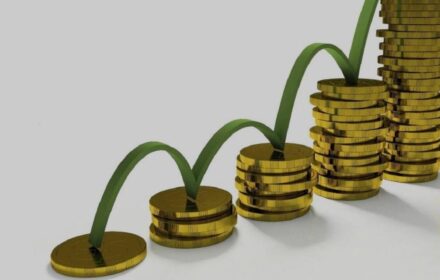The question of how to earn on interest rates is always relevant for those who systematically build their personal finances. Tools allow you to increase capital without the need for daily market monitoring, but the quality of the result depends on which formats are included in the portfolio and how risks are distributed. In 2025, an investor faces a wide choice: from traditional deposits to p2p lending and real estate rental. The task is to choose a strategy that will provide predictable profitability, maintain reliability, and ensure liquidity so that part of the funds can be used at any time.
The essence of income: how to earn on interest rates
The easiest way to understand how to earn on interest rates is through an example. A bank accepts a deposit of 500,000 ₽ at 7% per annum with monthly capitalization. After a year, the amount will turn into 537,931 ₽. If you do not withdraw the profit and continue to keep the funds in the account for five years, the capital will grow to 701,274 ₽. Compound interest turns time into the main lever of growth. The same logic works in bonds, where the coupon can be reinvested, and in crowdfunding, where the profit from one loan goes into the next. Therefore, the main strategy of how to earn on interest rates is not just to choose a rate, but to establish a reinvestment cycle.
Portfolio of 2025: three layers of profitability
Earning on interest rates correctly means forming a multi-level portfolio where each part solves its own task. In 2025, the basic structure looks like this:
-
Reliable layer. Deposits and federal loan bonds. Interest rates of 6–8% per annum, high reliability, quick liquidity.
-
Medium layer. Corporate bonds, crowdfunding, p2p lending. Yield of 10–14% per annum, moderate risk, diversification through dozens of positions.
-
Income layer. Real estate for rent, commercial properties, or investments through real estate funds. Yield from 8% on housing to 15% in the commercial sector, low liquidity, but stable cash flow.
This system allows capital to be increased steadily: one part works for reliability, the other for growth.
Deposits: a foundation without excessive profitability
Earning on interest rates through deposits is the first step for novice investors. Bank deposits offer low risk and predictable results. It is important to choose conditions with interest capitalization and also check the deposit insurance limit. For example, placing 1 million ₽ at 7.2% per annum will bring in about 72,000 ₽ per year. The amount may not seem huge, but it creates a liquidity cushion and protects the portfolio from the instability of other instruments.
Bonds: risk control and stable payments
Bonds are the second basic instrument. Government securities with yields of 6–7% are available, corporate bonds range from 8 to 11%. For example, buying bonds from a large issuer with a 9% coupon for 200,000 ₽ will bring in 18,000 ₽ per year. The investor receives not only income but also flexibility: securities can be sold early on the exchange. It is important to consider the risk of issuer default, so bonds of different companies and different maturity dates are included in the portfolio.
P2P Lending and Crowdlending: Higher Income, Higher Risk
Earning on interest rates through p2p platforms and crowdlending can be shown with numbers. The average rate is 12–15% per annum. An investor allocates 100,000 ₽ to 50 loans of 2,000 ₽ each. Even if 2–3 borrowers do not repay the debt, the overall profitability will remain positive. Crowdlending provides the opportunity to participate in small business lending: the rate reaches up to 16% per annum, but requires careful platform and borrower verification.
Real Estate and Rental: Interest in the Form of Monthly Payments
For example, a 5 million ₽ apartment in a residential area brings in an average of 35,000 ₽ per month in rent. The annual income will be 420,000 ₽, or 8.4% of the value. If the property is financed by a mortgage at 6% with an initial payment, the net yield increases. Here, the principle of leverage works: rent covers payments, and the invested capital generates income above the average market rate.
Online Tools: Automation and Accessibility
Understanding how to earn on interest rates online has become easier thanks to digital platforms. Brokers allow buying bonds in mobile applications, banks offer automatic deposit rollovers, and p2p services automatically allocate capital among hundreds of borrowers. An investor sets parameters — amount, term, yield — and receives passive income in the form of interest without daily monitoring. Technologies provide transparency and reduce costs.
**Taxes, Mistakes, Optimization, and Capital Protection: How to Legally Earn on Interest Rates**
The question of how to earn on interest rates must be considered together with taxes. The personal income tax rate on interest income is 13%. However, there are benefits: a tax deduction on an individual investment account allows you to get back up to 52,000 ₽ per year by investing 400,000 ₽. Using this tool increases the net profitability of the portfolio and makes interest-bearing investments more efficient.
Three common problems of earning: concentration of capital in one instrument, ignoring inflation, and focusing only on profitability without considering risk. To increase capital, it is necessary to diversify, allocate funds by terms, and maintain liquidity. Only in this way do interest rates turn into real passive income, not risky experiments.
Conclusion
Earning on interest rates in 2025 means building a portfolio with several levels: deposits and bonds provide the foundation, p2p lending and crowdlending create the middle layer, real estate and rental form the income stream. Compound interest, tax benefits, and smart allocation turn the format into the main tool for capital growth. With regular monitoring, the investor gains reliability, profitability, and liquidity simultaneously.
 en
en  ru
ru  de
de  ar
ar  es
es  nl
nl  hi
hi  fr
fr  it
it  pt
pt  el
el 



